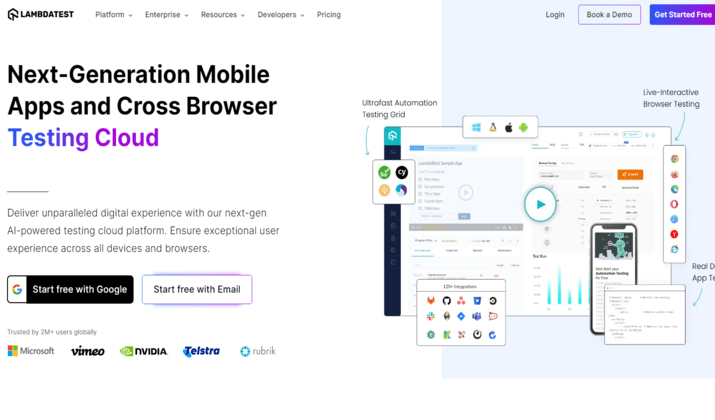Confused about which platform to choose for testing your web applications? Although the options are overwhelming, it would be a good idea to start with a comparison of LambdaTest vs Selenium.
The two are among the most popular testing platforms for software applications, offering cross-browser testing, automated testing with support for multiple programming languages among other features.
Both platforms offer a range of benefits, but which one is truly better? Is LambdaTest the superior option, or does Selenium have the edge?
Let’s explore and compare the capabilities of LambdaTest and Selenium to find out more.
LambdaTest vs Selenium – Overview & Features
LambdaTest
Designed to meet the needs of developers and QA professionals, LambdaTest is a comprehensive testing platform. It offers a wide range of features and capabilities that make it a top choice for testing applications.
Here are some key features of LambdaTest:
- HyperExecute: HyperExecute is a feature in LambdaTest that allows users to run multiple test cases simultaneously in different browser and platform combinations, optimizing resource utilization and reducing testing efforts.
- Real Device Cloud: LambdaTest provides a Real Device Cloud feature that enables users to test their web applications on real devices, ensuring accurate testing across different devices and operating systems.
- Smart TV Testing: With Smart TV testing, LambdaTest allows users to test the compatibility and functionality of their web applications on Smart TVs, ensuring a seamless user experience on these devices.
- AI-Powered Testing: LambdaTest incorporates AI-powered testing capabilities to enhance the testing process by automating repetitive tasks, improving test coverage, and detecting errors more efficiently.
- Localization Testing: The Localization Testing feature in LambdaTest enables users to test their web applications for different languages, regions, and cultural preferences, ensuring that the application functions correctly in diverse global markets.
These features collectively make LambdaTest a comprehensive testing platform that caters to a wide range of testing requirements, from cross-browser testing to localization testing, with the integration of advanced technologies like AI to streamline the testing process.
Also read: 6 Best LambdaTest Alternatives
Selenium
Selenium is a widely-used open-source automation testing framework specifically designed for web application testing.
It provides developers and QA professionals with a powerful toolset for automating the testing process and ensuring the quality of web applications.
Here are some notable features of Selenium:
- Open Source Accessibility: Selenium is an open-source tool, allowing users to download and use the source code freely. This accessibility enhances the functionality of predefined functions and classes, making it a dependable web automation tool.
- Multi-Language Support: Selenium supports various programming languages like Java, Python, C#, Ruby, Perl, and more, providing flexibility for testers to work with the language they are comfortable with. This multi-language support simplifies test script development and execution.
- Cross-Browser Compatibility Testing: Selenium supports automated cross-browser testing across major browsers like Chrome, Firefox, Safari, Opera, IE, Edge, and more. This feature ensures consistent functionality across different browsers, streamlining the testing process.
- Platform Support: Selenium can operate across multiple operating systems such as Windows, Mac, Linux, and UNIX. Test scripts created on one platform can be executed seamlessly on another, enhancing flexibility and efficiency in testing.
- Support for Multiple Frameworks and Languages: Selenium can be integrated with various frameworks like Maven or ANT for source code compilation and with testing frameworks like TestNG for application testing and reporting. This integration capability simplifies automation testing with Selenium WebDriver and supports continuous integration and deployment.
- Cross-Device Testing: Selenium enables testing automation across various devices, including iPhones, Blackberry, and Android, facilitating cross-device testing and addressing compatibility issues effectively.
Check out: Perfecto vs LambdaTest – Which Is Better?
LambdaTest vs Selenium – Key Benefits
LambdaTest
Whether you are conducting cross-browser testing, automated testing, or visual testing, LambdaTest has you covered with benefits that include:
- User-Friendly Interface: LambdaTest provides a very user-friendly interface with the latest devices and browser versions, making it easy to use and navigate.
- Cross-Browser Testing: One of the significant advantages of LambdaTest is its ability to perform automated cross-browser testing across a wide range of real browsers, platforms, and device emulators.
- Parallel Testing: LambdaTest allows users to run multiple test cases simultaneously in different browser and platform combinations, reducing testing efforts and optimizing resource utilization.
- Visual Cross-Browser Testing: Users can perform visual cross-browser testing across various devices and operating system combinations, generating full-page screenshots during the test cycle for visual verification.
- Integration Capabilities: LambdaTest seamlessly integrates with popular CI/CD tools like Jenkins, GitLab CI, and more, enhancing the testing workflow and automation process.
- Responsive Testing: With features like LT Browser, LambdaTest enables users to check the responsiveness of websites on major devices and viewports, ensuring a consistent user experience across different screen sizes.
- Cost-Effective Infrastructure: Utilizing cloud-based testing tools like LambdaTest can be more cost-effective compared to maintaining an in-house testing infrastructure, reducing operational and maintenance expenses.
These benefits collectively make LambdaTest a valuable tool for users looking to streamline their testing processes, ensure cross-browser compatibility, and enhance the overall quality of their web applications.
You might find this useful: LambdaTest vs Tricentis Tosca – Which Is Better?
Selenium
Selenium offers a variety of benefits that make it a popular choice among developers and QA professionals.
Let’s explore some of the key benefits of Selenium:
- Parallel Test Execution: Selenium enables running test cases in parallel, reducing execution time and increasing efficiency in the testing process.
- Large Community Support: Selenium has a vast and active user community, providing ample resources and documentation for learning and troubleshooting.
- Playback and Record: Selenium IDE allows for the automatic recording of test cases based on browser interactions, simplifying the test case creation process.
- Flexibility and Extensibility: Selenium’s architecture allows for the extension of its functionality and integration with other tools, making it suitable for complex testing scenarios.
- Easier to Understand and Implement: Selenium commands are categorized into different classes, making it easier to understand and implement, especially for users new to automation testing.
Another related read: LambdaTest vs Sauce Labs – Which Is Better?
LambdaTest vs Selenium – Ease of Use
LambdaTest
Here’s what makes LambdaTest a user-friendly tool.
- Clean UI and Navigation: LambdaTest offers a polished user interface that enhances user experience. The platform’s intuitive design allows users to easily navigate through various features, making it simple to run test suits. Users can enter the URL to be tested, select the desired configuration, and quickly initiate their tests.
- Seamless Collaboration and Testing: LambdaTest facilitates seamless integration with major project management and bug tracking tools like Trello, Jira, Asana, Slack, Bugherd, and more. This integration allows testers and developers to efficiently collaborate and manage their testing processes within their existing workflows, enhancing overall productivity.
- Scalable and Reliable Selenium Grid: LambdaTest provides a secure, scalable, and reliable cloud-based Selenium Grid that enables users to run tests at a faster pace. By leveraging the capabilities of the Selenium Grid, users can execute tests simultaneously across multiple browser-OS combinations, ensuring extensive test coverage and boosting confidence in the product’s quality.
LambdaTest’s ease of use stems from its clean user interface, seamless collaboration features, and the scalability and reliability of its Selenium Grid, making it a user-friendly and efficient cross-browser testing tool.
You might find this interesting: Ghost Inspector vs LambdaTest – Which Is Better
Selenium
Selenium is praised for its ease of use due to several key features that enhance user experience. Some of these include:
- Open-Source and Free: Selenium is an open-source suite of tools, making it a cost-effective solution for web automation testing. This accessibility allows developers and testers to utilize Selenium without financial constraints, making it widely available and easy to adopt.
- Comprehensive Testing Capabilities: Selenium allows for functional testing, regression testing, and end-to-end testing of websites and web applications. Its ability to cover a wide range of testing scenarios ensures thorough test coverage, ensuring the quality of web applications.
- Efficiency and Accuracy: Selenium WebDriver, a key component of Selenium, interacts directly with web browsers using browser-specific native tools. This eliminates the need for Selenium RC. As a result of this direct interaction, the efficiency and accuracy in test execution improves.
Also read: LambdaTest vs Appium – Which Is Better?
LambdaTest vs Selenium – Drawbacks
LambdaTest
Despite all the plus points, LambdaTest has certain drawbacks. Let’s take a look.
- Lack of Native App Testing and Real Devices: Some users have expressed disappointment with the absence of native app testing and real devices on the platform. This limitation can hinder the comprehensive testing of mobile applications. It may also impact the accuracy of test results, especially for native mobile apps.
- Slow Loading Times for Test Environments: On rare occasions, users have reported that LambdaTest could be a bit slow to load the test environments. This delay in loading test environments can be a concern, particularly when there is a need to test multiple browser/device/OS combinations quickly.
- Limited Pricing Options for Specific Testing Needs: Some users have suggested that LambdaTest could offer more specialized pricing options. For instance, discounts for specific types of tests like mobile-only testing would be welcome.
- Sluggishness in live apps: There have been reports of occasional slowness in the live apps on LambdaTest. This can potentially impact the speed and efficiency of your testing process.
- Lack of ample device vendors: Some users have suggested the inclusion of more device vendors on the platform, which would expand the device and browser coverage for testing purposes.
These drawbacks highlight areas where LambdaTest needs to improve.
Read this too: LambdaTest vs Cypress – Which Is Better?
Selenium
Just like LambdaTest, Selenium too, falls short in some areas.
- No Built-in Reporting Mechanism: Selenium lacks built-in reporting capabilities. Consequently, testers have to rely on third-party tools or custom code to generate comprehensive test reports.
- Steep Learning Curve: Selenium requires programming skills. This can pose a significant learning curve for beginners, leading to longer ramp-up times.
- High Test Maintenance: Test scripts developed with Selenium may require frequent updates and maintenance as web applications evolve. As a result, maintenance efforts become time-consuming and resource-intensive.
- Limited Support for Mobile Testing: While Selenium can test mobile web applications, it has limited support for native mobile applications. Subsequently, it requires additional tools like Appium for testing native mobile apps.
- Inability to read images without additional plugins: The inability to read images without the use of additional plugins may hinder image-based testing scenarios. This includes verifications based on visual elements or comparisons of rendered images across different browsers.
- Limited Control Over Network Activities: Selenium does not offer direct control over network activities such as throttling or simulating different network conditions. This can be a limitation in certain testing scenarios.
- Occasional Flaky Tests: Some users have reported occasional flaky tests when using Selenium. Flaky tests may produce inconsistent results or fail intermittently. Often, this happens due to factors such as timing issues, asynchronous operations, or unstable test environments.
Conclusion
While choosing the right testing platform for your needs, considering the differences between LambdaTest and Selenium is crucial.
LambdaTest shines in cross-browser testing. It provides a comprehensive solution for ensuring your web application works seamlessly across different browsers and operating systems.
Selenium, on the other hand, is widely recognized for its automation capabilities and extensive community support. It allows users to write test scripts in their preferred programming language and offers flexibility and customization.
If cross-browser testing and visual testing are your priorities, LambdaTest is an excellent choice. However, if automation and community support matter to you, Selenium may be the better option.
Assess your specific needs, evaluate the level of customization required, and consider the resources available. This will help you make an informed decision on the best testing platform for your project.













